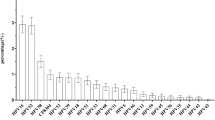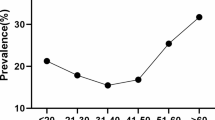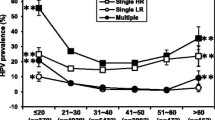Abstract
In this hospital-based descriptive study, the genotype distribution of human papillomavirus (HPV) among HPV-infected women were investigated in 4,305 gynecological patients in Sichuan province. Females attending gynecology clinics between March 2014 and March 2015 were subjected to HPV screening after giving informed consent. Cervical scrapings were examined by cytopathology and colposcopy-directed biopsies. HPV genotyping was performed on a Luminex 200 system. Seventeen high-risk (HR) genotypes (HPV-16, -18, -31, -33, -35, -39, -45, -51, -52, -53, -56, -58, -59, -66, -68, -73, and -82) and seven low-risk (LR) genotypes (HPV-6, -11, -42, -43, -61, -81, and -83) were detected. Among all HPV-positive women, 34.1% (1,467/4,305) of the cases showed abnormal cytology and biopsy, including high-grade squamous lesions (HSIL), cervical intraepithelial neoplasias of grades 2 and 3 (CIN2/CIN3), and cervical cancer (CC). HPV-16, -52, and -58 were the predominant genotypes, followed by HPV-56, -18, -59, -39, -53, -33, and -81. A total of 3,785 (87.9%) HPV positive women were found to have HR HPV infection, while 859 (20.0%) were found to have LR HPV infection. Among all patients, 79% (3,401/4,305) were infected with a single strain of HPV, 85.5% (2,907/3,401) cases of which were of the HR HPV genotype. In cervical precancerous lesions (CPLs) and CC patients, HR HPV-16, -58, -52, -33, and -18 were the predominant genotypes. Interestingly, 33 CPL patients had a single LR HPV infection with HPV-61, -11, -81, -6, -43, or -42. Furthermore, one CC patient was infected only with LR HPV-11. According to the abundant genotype diversity of HPV in Sichuan, we suggest that a large-scale epidemiological investigation should be launched, not only to understand the distribution of HPV genotype, but also to provide information needed for HPV vaccination programs and to predict the effectiveness of current vaccines in Southwest China.
Similar content being viewed by others
References
An HJ, Cho NH, Lee SY, Kim IH, Lee C, Kim SJ, Mun MS, Kim SH, Jeong JK (2003) Correlation of cervical carcinoma and precancerous lesions with human papillomavirus (HPV) genotypes detected with the HPV DNA chip microarray method. Cancer 97(7):1672–1680
Bachtiary B, Obermair A, Dreier B, Birner P, Breitenecker G, Knocke TH, Selzer E, Potter R (2002) Impact of multiple HPV infection on response to treatment and survival in patients receiving radical radiotherapy for cervical cancer. Int J Cancer 102:237–243
Baloch Z, Yuan T, Wang B, Tai W, Feng Y, Liu Y, Li X, Feng Y, Liu L, Zhang AM, Wu X, Xia X (2016) Ethnic and geographic variations in HPV prevalence and genotype distribution in north-western Yunnan, China. J Med Virol 88:532–540
Baloch Z, Yuan T, Yindi S, Feng Y, Tai W, Liu Y, Liu L, Zhang A, Wang B, Wu X, Xia X (2016) Prevalence of genital human papillomavirus among rural and urban populations in southern Yunnan province, China. Braz J Med Biol Res 49:e5254
Bao YP, Li N, Smith JS, Qiao YL, Members A (2008) Human papillomavirus type distribution in women from Asia: a meta-analysis. Int J Gynecol Cancer 18:71–79
Basu P, Chandna P, Bamezai RN, Siddiqi M, Saranath D, Lear A, Ratnam S (2011) MassARRAY spectrometry is more sensitive than PreTect HPV-Proofer and consensus PCR for type-specific detection of high-risk oncogenic human papillomavirus genotypes in cervical cancer. J Clin Microbiol 49:3537–3544
Bouvard V, Baan R, Straif K, Grosse Y, Secretan B, El Ghissassi F, Benbrahim-Tallaa L, Guha N, Freeman C, Galichet L, Cogliano V, Group WHOIAfRoCMW (2009) A review of human carcinogens—part B: biological agents. Lancet Oncol 10:321–322
Brandstetter T, Bohmer S, Prucker O, Bisse E, zur Hausen A, Alt-Morbe J, Ruhe J (2010) A polymer-based DNA biochip platform for human papilloma virus genotyping. J Virol Methods 163:40–48
Ceccato Junior BP, Guimaraes MD, Lopes AP, Nascimento LF, Novaes LM, Del Castillo DM, Melo VH (2016) Incidence of cervical human papillomavirus and cervical intraepithelial neoplasia in women with positive and negative HIV status. Rev Bras Ginecol Obstet 38:231–238
Chen Z, Wang Q, Ding X, Li Q, Zhong R, Ren H (2015) Characteristics of HPV prevalence in Sichuan Province, China. Int J Gynaecol Obstet 131:277–280
Clifford GM, Gallus S, Herrero R, Munoz N, Snijders PJ, Vaccarella S, Anh PT, Ferreccio C, Hieu NT, Matos E, Molano M, Rajkumar R, Ronco G, de Sanjose S, Shin HR, Sukvirach S, Thomas JO, Tunsakul S, Meijer CJ, Franceschi S, Group IHPSS (2005) Worldwide distribution of human papillomavirus types in cytologically normal women in the International Agency for Research on Cancer HPV prevalence surveys: a pooled analysis. Lancet 366:991–998
Dai M, Bao YP, Li N, Clifford GM, Vaccarella S, Snijders PJ, Huang RD, Sun LX, Meijer CJ, Qiao YL, Franceschi S (2006) Human papillomavirus infection in Shanxi Province, People’s Republic of China: a population-based study. Br J Cancer 95:96–101
Ferlay J, Soerjomataram I, Dikshit R, Eser S, Mathers C, Rebelo M, Parkin DM, Forman D, Bray F (2015) Cancer incidence and mortality worldwide: sources, methods and major patterns in GLOBOCAN 2012. Int J Cancer 136:E359–E386
Herrero R, Castle PE, Schiffman M, Bratti MC, Hildesheim A, Morales J, Alfaro M, Sherman ME, Wacholder S, Chen S, Rodriguez AC, Burk RD (2005) Epidemiologic profile of type-specific human papillomavirus infection and cervical neoplasia in Guanacaste, Costa Rica. J Infect Dis 191:1796–1807
Hibbitts S, Rieck GC, Hart K, Powell NG, Beukenholdt R, Dallimore N, McRea J, Hauke A, Tristram A, Fiander AN (2006) Human papillomavirus infection: an anonymous prevalence study in South Wales, UK. Br J Cancer 95:226–232
Hildesheim A, Herrero R, Castle PE, Wacholder S, Bratti MC, Sherman ME, Lorincz AT, Burk RD, Morales J, Rodriguez AC, Helgesen K, Alfaro M, Hutchinson M, Balmaceda I, Greenberg M, Schiffman M (2001) HPV co-factors related to the development of cervical cancer: results from a population-based study in Costa Rica. Br J Cancer 84:1219–1226
Hildesheim A, Wang SS (2002) Host and viral genetics and risk of cervical cancer: a review. Virus Res 89:229–240
Humans IWGotEoCRt (2012) Biological agents. Volume 100 B. A review of human carcinogens. IARC Monogr Eval Carcinog Risks Hum 100:1–441
International Collaboration of Epidemiological Studies of Cervical C (2006) Cervical carcinoma and reproductive factors: collaborative reanalysis of individual data on 16,563 women with cervical carcinoma and 33,542 women without cervical carcinoma from 25 epidemiological studies. Int J Cancer 119:1108–1124
Kahn JA, Burk RD, Squires KE, Kapogiannis BG, Rudy B, Xu J, Gonin R, Liu N, Worrell C, Wilson CM (2012) Prevalence and risk factors for HPV in HIV-positive young women receiving their first HPV vaccination. J Acquir Immune Defic Syndr 61:390–399
Kirschner B, Junge J, Holl K, Rosenlund M, Collas de Souza S, Quint W, Molijn A, Jenkins D, Schledermann D (2013) HPV genotypes in invasive cervical cancer in Danish women. Acta Obstet Gynecol Scand 92:1023–1031
Li J, Zhang D, Zhang Y, Wang X, Lin Y, Hu L (2011) Prevalence and genotype distribution of human papillomavirus in women with cervical cancer or high-grade precancerous lesions in Chengdu, western China. Int J Gynaecol Obstet 112:131–134
Nakagawa M, Spencer HJ, Coleman HN, Greenfield WW (2013) Distribution of human papillomavirus (HPV) types and anti-HPV T-cell immune responses among different racial/ethnic groups in Central Arkansas. J Ark Med Soc 109:160–163
Li N, Dai M (2008) Human papillomavirus infection in China: a multi-centric cross-sectional study. Chin J Dis Control Prev 12:411–415
Shikary T, Bernstein DI, Jin Y, Zimet GD, Rosenthal SL, Kahn JA (2009) Epidemiology and risk factors for human papillomavirus infection in a diverse sample of low-income young women. J Clin Virol 46:107–111
Walboomers JM, Jacobs MV, Manos MM, Bosch FX, Kummer JA, Shah KV, Snijders PJ, Peto J, Meijer CJ, Munoz N (1999) Human papillomavirus is a necessary cause of invasive cervical cancer worldwide. J Pathol 189:12–19
Wang L, Wang P, Ren Y, Du J, Jiang J, Jia X, Chen C, Wang Y (2016) Prevalence of high-risk human papillomavirus (HR-HPV) genotypes and multiple infections in cervical abnormalities from Northern Xinjiang, China. PLoS One 11:e0160698
Zhang HY, Fei MD, Jiang Y, Fei QY, Qian H, Xu L, Jin YN, Jiang CQ, Li HX, Tiggelaar SM, Smith JS, Sahasrabuddhe VV, Qiao YL (2014) The diversity of human papillomavirus infection among human immunodeficiency virus-infected women in Yunnan, China. Virol J 11:202
Zhao FH, Lewkowitz AK, Hu SY, Chen F, Li LY, Zhang QM, Wu RF, Li CQ, Wei LH, Xu AD, Zhang WH, Pan QJ, Zhang X, Belinson JL, Sellors JW, Smith JS, Qiao YL, Franceschi S (2012) Prevalence of human papillomavirus and cervical intraepithelial neoplasia in China: a pooled analysis of 17 population-based studies. Int J Cancer 131:2929–2938
Zhao R, Zhang WY, Wu MH, Zhang SW, Pan J, Zhu L, Zhang YP, Li H, Gu YS, Liu XZ (2009) Human papillomavirus infection in Beijing, People’s Republic of China: a population-based study. Br J Cancer 101:1635–1640
Acknowledgements
Funding was provided by National Natural Science Foundation of China (Grant no. 81572089).
Author information
Authors and Affiliations
Corresponding authors
Additional information
Handling Editor: Zhongjie Shi.
Rights and permissions
About this article
Cite this article
Tao, G., Yaling, G., Zhan, G. et al. Human papillomavirus genotype distribution among HPV-positive women in Sichuan province, Southwest China. Arch Virol 163, 65–72 (2018). https://doi.org/10.1007/s00705-017-3556-1
Received:
Accepted:
Published:
Issue Date:
DOI: https://doi.org/10.1007/s00705-017-3556-1




